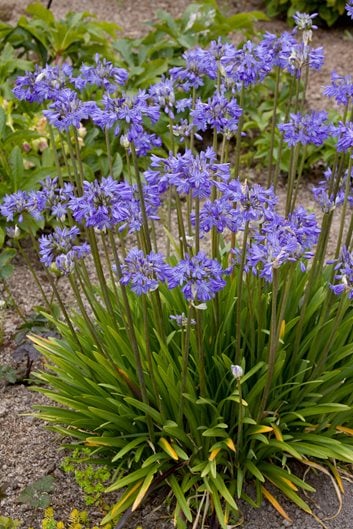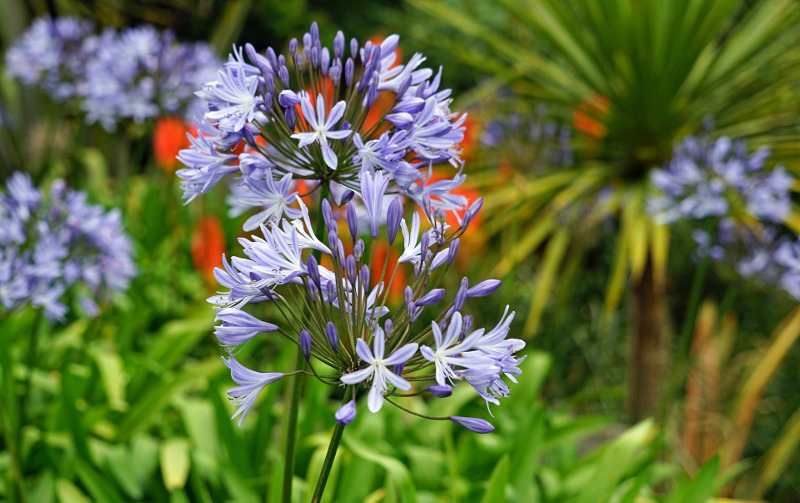Typical Agapanthus Troubles and Just How to Resolve Them
Typical Agapanthus Troubles and Just How to Resolve Them
Blog Article
Letting Loose the Secret to Successful Agapanthus Growing: Idea for a Flourishing Yard
In the world of horticulture, growing agapanthus successfully calls for a calculated method that encompasses different facets of plant care. By comprehending the nuances of agapanthus cultivation, one can create an atmosphere where these plants thrive and flower abundantly.
Planting Agapanthus: Ideal Practices
When growing Agapanthus, appropriate dirt preparation is important for guaranteeing effective growth and advancement of these beautiful flowers. Agapanthus, generally understood as Lily of the Nile or African lily, prospers in well-draining dirt with a slightly acidic to neutral pH level - Agapanthus. Before growing, it is crucial to modify heavy clay dirts with natural matter such as compost or peat moss to enhance drainage and give vital nutrients for the plants
To grow Agapanthus, select a place that receives full sunlight to partial shade, as this will advertise healthy growth and bountiful flowering. Dig an opening twice the size of the plant's root ball and position the Agapanthus at the exact same depth it was previously growing. Gently backfill the hole with soil, pushing down firmly to remove any type of air pockets around the roots.
Water the freshly grown Agapanthus thoroughly and proceed to maintain the dirt equally damp, especially during the plant's energetic expanding period. Agapanthus. Using a well balanced plant food once a month can additionally sustain the plant's development and blooming. By complying with these best techniques for growing Agapanthus, you can develop a stunning display screen of these exciting blossoms in your yard
Perfect Soil Issues for Agapanthus
For ideal development and flowering success of Agapanthus plants, guaranteeing the dirt conditions are suitable is crucial. Agapanthus grows in well-draining soil with a somewhat acidic to neutral pH degree varying from 6.0 to 7.0. This kind of soil permits for ample water drainage, protecting against waterlogging which can cause root rot. To boost soil drainage, think about adding natural matter such as garden compost or peat moss when preparing the planting website. Moreover, Agapanthus favors dirt that is rich in nutrients, so integrating a balanced fertilizer during the growing season can advertise healthy growth and vivid blooms.

Watering and Fertilizing Tips
To ensure healthy growth and lively blooms, correct watering and feeding methods are essential for successful Agapanthus growing. Agapanthus plants gain from normal watering, especially during the growing period. It is advised to water deeply when a week, guaranteeing the soil is damp however not saturated. During heat or in pots, more frequent watering might be essential to stop the dirt from drying entirely.
When it concerns feeding Agapanthus, a well balanced plant food with equivalent components nitrogen, phosphorus, and potassium can be applied in the springtime to promote healthy and balanced growth and flowering. Slow-release fertilizers are perfect for giving nutrients slowly over a prolonged period. Prevent over-fertilizing, as this can lead to extreme foliage growth at the cost of blooms.
Additionally, incorporating raw material like garden compost right into the dirt can get redirected here improve nutrient degrees and boost soil structure, helping in the overall health and wellness of the Agapanthus plants. By adhering to these watering and feeding ideas, gardeners can guarantee their Agapanthus plants prosper and create spectacular screens of blossoms.
Pruning and Deadheading Techniques
Appropriate trimming and deadheading methods play a crucial role in preserving the health and wellness and visual appeals of Agapanthus plants, enhancing the crucial techniques of watering and fertilizing for effective farming. Trimming Agapanthus entails getting rid of spent flower heads, dead or yellowing fallen leaves, and general shaping of the plant to advertise better growth. Deadheading, the process of getting his explanation rid of faded flowers, not just boosts the plant's look yet likewise motivates further growing.
When deadheading Agapanthus, it is advisable to trim off the blossom stem at the base utilizing sharp, clean shears. This procedure reroutes the plant's power from seed manufacturing back into origin and vegetation growth, advertising a healthier and a lot more durable plant. Normal deadheading can expand the blooming duration of Agapanthus and protect against self-seeding, which can lead to overcrowding.
In regards to pruning, Agapanthus generally benefits from a light trim after blossoming to clean up the plant and motivate fresh growth. Reducing the spent blossom stems and getting rid of any kind of damaged or dead foliage helps maintain the plant's vitality and total appearance. Nevertheless, it is important to stay clear of cutting right into the crown of the plant, as this can damage its wellness.

Protecting Agapanthus From Pests and Diseases
Executing efficient insect and illness management approaches is critical to guarding the health and vigor of Agapanthus plants in farming. One common parasite that influences Agapanthus is the Agapanthus borer, a caterpillar that moved here passages into the plant, creating damages to the blossoms and fallen leaves.
In addition to insects, Agapanthus are susceptible to illness such as origin rot and fungal leaf places. By staying attentive and dealing with insect and illness concerns without delay, gardeners can aid their Agapanthus grow and prosper.

Conclusion
Finally, successful growing of agapanthus calls for appropriate growing strategies, perfect dirt problems, ample watering and fertilizing, routine pruning and deadheading, and defense from parasites and illness. By complying with these tricks and suggestions, garden enthusiasts can make sure a flourishing garden full of gorgeous agapanthus blooms. Agapanthus. Remember to keep constant care and attention to detail to advertise the health and wellness and long life of these spectacular plants
When growing Agapanthus, correct dirt prep work is crucial for ensuring effective growth and growth of these lovely flowers.Water the freshly planted Agapanthus extensively and proceed to keep the soil uniformly moist, particularly during the plant's energetic expanding season.For optimal growth and growing success of Agapanthus plants, making certain the dirt problems are suitable is essential. When planting or transplanting Agapanthus, ensure the dirt is well-prepared to provide the necessary foundation for the plants to develop themselves efficiently. One common parasite that affects Agapanthus is the Agapanthus borer, a caterpillar that passages right into the plant, causing damage to the blossoms and fallen leaves.
Report this page